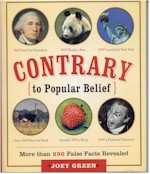 |
|
|
| ||||||
|
|
This page is the original source of this review, though you may also find it on Amazon or other sites. | ||
| Book Reviews Home | Free Audio Books | |
 |
Book Review of: Contrary to Popular BeliefMore than 250 False Facts Revealed Price: $9.60 Availability: Usually ships within 24 hours |
| Review of
Contrary to Popular Belief, by Joey Green (Softcover, 2012) (You can print this review in landscape mode, if you want a hardcopy) Reviewer: Mark Lamendola, author of over 6,000 articles. This book was a fun read, but falls short of its potential. The author's method is to posit a commonly-held belief and then present something to show the idea is either flatly false or isn't exactly true 100% of the time. This is where the failed potential starts becoming clear. In (I think) about half of the cases, he counters a wrong belief with the correct fact(s). These are "false facts" that are actually false and his explanations are correct. For example, he says penguins do not live only in freezing climates (page 109). That's fine, and how it should be. The reader can learn something. But in the other half, his "counterargument" reminds me of those groaner brainteaser questions that rely on word games, irrelevancies, or slightly twisted logic for the answer. Those brainteasers are designed not to test your knowledge but to test your ability to come up with "off the wall" answers that are true if you really take license with language and logic. Mr. Green does the same thing through much of this book. What I'm saying here is many of the facts he presents as false are actually true. For example, he says it's false that British prisoners settled Australia (page 37). But, indeed, they did. His counterargument is all about who arrived there first. Arriving and settling are two different things, so his counterargument is irrelevant and the original fact remains as unchallenged. What I found in going through these was I already knew nearly all of the "actually false" items and their explanations. I can tell you that most people don't know these things. And if he'd written the book confined to only these things, he'd have had an honest work that is both interesting and entertaining. By inflating the book out with the "not actually false" items and really stretching both logic and our language to "prove" they were false, he did the book and the reader a disservice. If he revised this book for a second edition with those items removed (even if not replaced), it would be a much better book. Those (removed) items belong in a different book with different title. Maybe something like, "Groaners for Parties." If you want to be able to whip out some semantic groaners at a dinner party, you can memorize a few of the "not actually false" items and then laugh uproariously at the silliness of what you just said. While writing this review, I paged through this book to see if all of the items were trivia or of some were of a more serious nature. It seems they're all trivia. Many popular notions are harmful and could have been included. For example, in the USA our disease-fetish culture includes an atrocious diet (grain-based, highly processed foods, calorie-dense, nutrient-sparse) and an aversion to hard physical exercise such as weight training on a systematic basis. One excuse people have for not having an exercise program is "that muscle just turns to fat when you get old." But muscle does not turn into fat or vice-versa. This myth helps people stay unhealthy. Another example is the myth that letting the air out of your tires in winter gives you better traction on the snow and ice. Anyone who knows anything about tires and the physics involved will tell you this notion gets people killed--and not just the folks driving around on low tires but also the people whose cars they smash into. For best traction, regardless of the weather or what you're driving on, you want your tires properly inflated to their rated PSI. Or what about the common "remedy" of putting hydrogen peroxide on a cut or other small wound? People believe this helps, but actually it destroys healthy tissue and causes healing to take longer. Mr. Green could have addressed a dozen common health and safety myths in place of a dozen of his "not actually false" items, thereby not only making the book more accurate but also actually useful. It's not that I'm disappointed or disgusted with this book. It's that it easily could have been much better. | |
| |||||